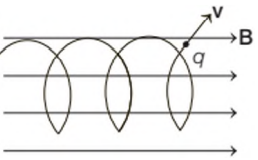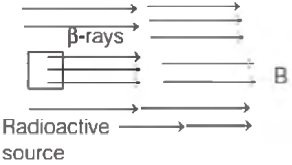Lorentz Force and Its Effects
A charged particle moving in an external magnetic field experiences a force, which is called Lorentz force, i.e. `F=q(v xx B)`,
where `q` is the charge on the particle and v is the velocity of the particle. The direction of the force is given by the cross product of velocity vector and magnetic field vector at any time.
The charge particle travels in a special trajectory called helical path. Because the force is always perpendicular to the velocity vector, the magnetic field can do no work on an isolate charge. Hence, the linear velocity always remains the same.

An radioactive nuclei emits `beta`-rays. In a uniform magnetic field shown in the figure, the `beta`-rays

Options:
(a) will get deflected upwards
(b) will not get deflected
(c) will get deflected downwards
(d) will get deflected out of the plane of the paper